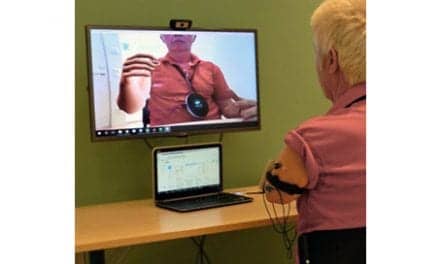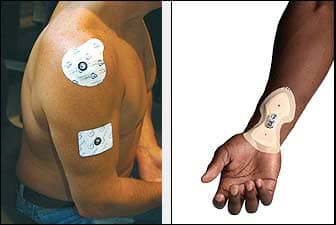 |
When used as part of a complete physical therapy package, ultrasound can be a blessing in disguise for patients recovering from sports-related injuries. Especially injuries where localized healing is the main focus.
Ultrasound was first used in the 1940s and 1950s by the military for sonar, and when they saw that it increased the temperature of the fish in the ocean, they thought it might be a good tool for heating injuries on patients, says Michelle H. Cameron, MD, PT, OCS, an Oakland, Calif-based clinician, teacher, researcher, and author.
The ultrasound machine or the ultrasound head has a crystal that an electric current passes through, causing vibrations that produce a high-frequency sound wave. When that sound wave is passed through the body using a water-based medium, it produces deep heat that physical therapists can use to help loosen tight tissues.
According to Julie Silver, MD, assistant professor at the Harvard Medical School Department of Physical Medicine and Rehabilitation, and attending physician at Spaulding Rehabilitation Hospital, ultrasound is believed to be effective in part due to its ability to heat tissues. This heating mechanism is thought to be responsible for increasing blood flow, as well as metabolic and enzymatic activity. “There are also nonthermal effects such as possibly changing cell wall permeability that may enhance or accelerate healing and reduce pain,” she says.
“The main reason that I use ultrasound is to loosen up soft tissue, to increase circulation,” says Jeff Harband, PT, of Mill Valley Physical Therapy and Sports Rehabilitation, Mill Valley, Calif. “I notice that patients feel better when I use it.”
DEEPLY PENETRATING HEAT
One of the benefits of using ultrasound is that the heat penetrates deep into the area being treated. In a surgical situation, a patient may have built up scar tissue or fluid that has hardened, causing pain. By using ultrasound, the heat will increase blood flow to the region, which then helps break up the tissue and get things moving again. Another possible benefit of ultrasound is that it is thought to increase the metabolism of the cells that it is striking, so it speeds healing and saves muscle tissue, Harband says.
“If there’s a lot of scar tissue in that area, then we would use ultrasound because it helps to break down the scar tissue so later when we actually do the soft tissue massage, it helps to break it down further. It helps loosen things up,” says Priti Ravishankar, PT, with Quinn Orthopedic Physical Therapy, Cupertino, Calif.
When using ultrasound in treating sports-related injuries, Cameron says, it can be utilized in various stages of the healing process. She says studies show that the earlier the treatment, the better the recovery, although ultrasound can be used at any point in a patient’s treatment.
“From my experience, the ultrasound itself will work anywhere from promoting protein production and tissue healing all the way up through creating some tissue extensibility when someone’s in a chronic healing phase and they are tight and need stretching,” says Dawn McCrory, PT, DPT, LAc, with Beyond Physical Therapy, Marina del Rey, Calif. “Ultrasound can really help add some extensibility into the tissues. If you’re using the ultrasound to gain extensibility in the tissue for stretching purposes, then it would affect pain because it would relieve the stiffness in the joint as you gain more extensibility in the tendon.”
She says there is an appropriate way to use ultrasound, including the way a therapist should diagnose a patient as a candidate for ultrasound.
“The best tissues—from my experience and from the literature—that work well and respond well to ultrasound have high collagen density, as in tendons and ligaments,” she says. “Muscle tissue in general doesn’t really absorb ultrasound too well, but if there’s a tendon injury or a ligament sprain, then ultrasound I think can be very effective.
“Depending on where the tissue lies in the body, you would then need to determine the appropriate megahertz or the appropriate frequency,” she says. “And then you have to properly determine the intensity that you want based on the area that you’re going to treat. If it’s a fairly large area, you need a much greater time frame in order to give the appropriate intensity.”
A COMPLEMENT TO OTHER MODALITIES
Because the treatment takes only about 5 to 10 minutes, Harband uses ultrasound in combination with other therapies, such as massage or stretching, primarily because ultrasound does help loosen soft tissue.
“Generally, in our clinic, a patient comes in and we usually set them up with heat or ice, depending on the injury, then electrical stimulation, and then after that we do ultrasound,” he says. “And again, you can do continuous ultrasound if you’re really looking for tissue heating and circulation, or you can do pulse ultrasound if there’s already inflammation present.”
“When I use ultrasound, I try to limit it to anywhere from 5 to 10 minutes, which means I have to choose a fairly small area,” McCrory says. “I would probably say 8 minutes is the most I use, which means you really have to keep a rather small area.”
Ultrasound should be used in small areas, she says, since larger areas are not practical because of the size of the ultrasound head. Cameron agrees, saying the maximum focus area should be around 5 by 10 cm.
“I usually go by the rule of my fist,” McCrory says. “If the area fits in the size of my wrist, it’s about 5 minutes. If it’s a little bigger, I’ll add on a couple more minutes depending on the area.”
Another way ultrasound is used is to push medications through the skin. The ultrasound would be set at a pulsed rate, and the medium would have an anti-inflammatory in it, a technique called phonophoresis. That pulsed setting will push the anti-inflammatory through the skin to get it deep into the muscles or into the joint, depending on where a therapist is trying to get it to go. For example, when treating Achilles tendonitis, ultrasound could be used to help increase the blood flow, and get the tendon to loosen up.
“Ideally, when something like that comes up, I would think of ultrasound, whereas if it were a joint, I would think of an electrical stimulation kind of modality,” says Ravishankar.
And there are some patients who are just not good candidates for ultrasound.
“We can’t use it on patients who have pacemakers, who’ve had cancer in certain areas, or who are pregnant,” Ravishankar says. “We rule out all these things and then we think about if ultrasound is beneficial or not. It totally depends on the person.”
MATTERS OF SPORTS AND PAIN
Other modalities therapists might consider when treating sports-related injuries for pain management include TENS and electric stimulation.
“The purpose of TENS is to control pain, which can be useful in sports-related injuries if you think the person can then be active in a safe way without having pain limiting them,” Cameron says. “Electrical stimulation can more globally be used either for pain control as TENS or to produce muscle contractions, which can be helpful when the person can’t contract actively themselves.”
However, Cameron says that while these modalities are physical agents, TENS can be used by a patient at home, while electric stimulation and ultrasound are used by a therapist in a facility setting.
Morgan Saffari is associate editor of Rehab Management.





